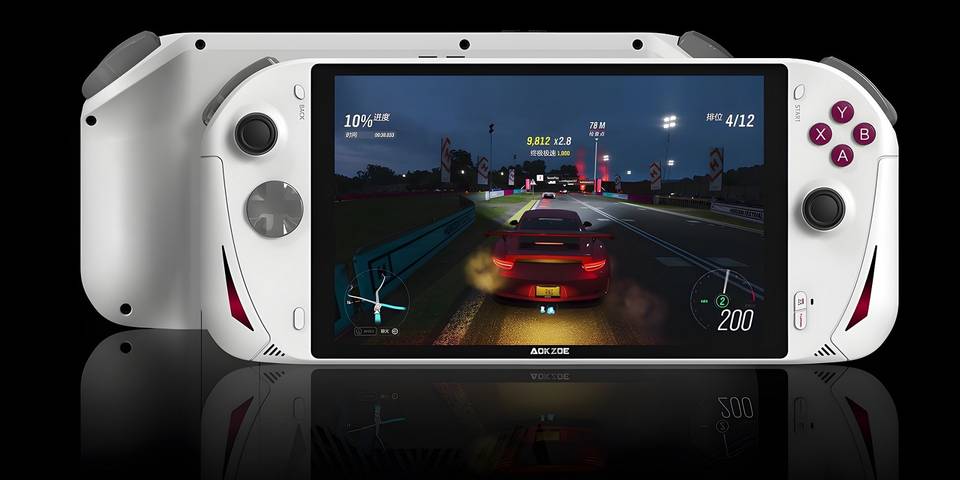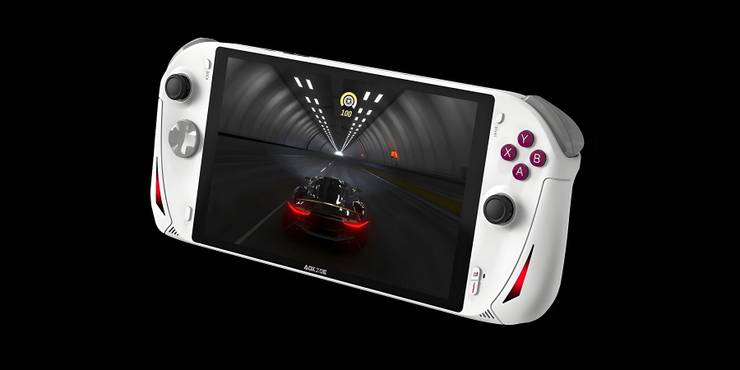Thought I'd share my impressions with the device here now that it's actually shipped (most of these are advertised months - sometimes longer - in advance, and A1 is still the only one of it's kind actually shipping to customers right now - ie. it IS the most powerful handheld on the market as of this moment), and didn't want to start another thread - there's enough of these already.
Background, I'd pre-ordered SteamDeck back in February, and by the time this kickstarter was live, my Deck was still slated to ship in late Q4. With original date for A1 being 'end of Sep' that was potentially months ahead of being able to get a Deck so I gambled. In the end - I received the device about 1.5 months later than og. date - but given I'd already waited 9 months on a Deck by then that hasn't really felt like significant delay in comparison.
Opted for quantum-blue, which turns out to be a darker hue than advertisement would suggest but the look/design is actually really nice.
Directly comparing with a Deck - 'build quality' of the outer shell feels more solid (Deck has a bit of flimsiness to it that I actually expected from this device, but it isn't the case), and surprisingly comfortable to hold (especially after years of Nintendo/Sony handhelds that were always - a bit of a pain to hold for extended periods of time).
The A1 is a bit smaller than Deck (2cm less on the width), which to me felt like the right balance (I found Deck just a touch long) and houses a much larger 8" screen which really ups the experience (the only thing I'd wish now is for a revision with an Oled screen some-day).
Performance/thermals are great. For a very direct comparison on the former - this is as close to a handheld Series S (especially with GamePass on it) as you're likely to get, and it easily trades blows with the console in most games, and even outperforms it in select ones (eg. it breezes through Scorn at 60fps @ 28W with settings maxed out and FSR @ Quality, and it can get 60 hz in the Ascent, and decent 30 with Raytracing on
***). It also scales really well to older games or more 2d fare, with some stuff running maxed out as low as 5-6Watts (eg. Carto or Hades), and getting maxed out 60 from most PS3/PS4 era titles with ease (NFS titles are really nice to revisit on this, P5 Royale outperforms all consoles except PS5/XSX etc.). The fact this comes with an 8-core Zen3 really shows in older console games, where even more powerful GPUs in consoles are still held back in what they can do framerate wise, and indeed many PS4 or older titles I've tested so far, tend to run maxed out at 15W or less.
RT is a mixed bag - some games surprise positively (like the Ascent, or Quake 1 path-traced) others are kind of stretching the realm of 'playable' (Lego Builder is doable, but you have to use really aggressive FSR and ghosting/temporal IQ is a bit out of control). Still - getting playable realtime raytracing on a handheld, is something of a nice surprise.
For another angle (and where thermals also come into play) it does really well against a GF1060 (which is on paper TF match), and I have one of those with Surface Book 2. Generally performance is at least a match, most cases it will outperform the SB2, but the big difference is that in all of them, it barely gets warm to hold, where as the laptop really heats up during play and - when using its own screen, will often throttle the CPU (which is in the screen part of the chasis).
Another thing that surprised me was how - generally well - things do out of the box, it's been a less fiddly ride than what I usually experience on my desktop/laptop setups, particularly since controller is natively integrated into Windows build installed, and hw-control widget (for Wattage/fan speeds etc.) is easy to use. There's no out of the box support for changing screen refresh (though that seems to be in the works) but manually configuring custom refresh-rate resolutions works well, and having native 40/45/50hz options actually does wonders for some harder to run games (or just to save on battery usage).
Minor gripe is that preinstalled controller driver shows up as Xbox controller, meaning that you don't get access to Gyro controls out of the box. Custom software (like Handheld companion) fixes this, and gyros work really well for all the usual use cases (personally I like Gyro aim when scoping, or mouse controls on some titles) but just an FYI.
*** Not everything is a positive and the usual PC caveats apply. The Ascent's DX12 mode, while performing well with/without RT(and even giving access to FSR2.X) is hopelessly broken as it stutters so bad it's borderline nausea inducing - DX11 mode is solid, but you lose out on the RT and temporal-upscaling

The same kind of things can be seen throughout PC software stack - including older games (eg. Mirror's Edge Catalyst is a very bumpy ride, and even some much older games will have I/O stalls creep up, just like I remember them). There's a chance some of this might be better if running a SteamOS install, but I haven't had the time to try that out yet.
I also run into oddities (very PC like ones at that) - eg: Forza Horizon 5 natively supports FSR2 but toggling it on actually drops performance when set to 'Quality' compared to native res. In that title- even just temporal AA runs 5-10% worse than native which is unusually expensive, and I've not quite decided yet, but native res + no AA may actually be preferable way to play FH5 for results you get.
In the Klonoa collection, the first game performs about 3-4x worse than the 2nd. In practical terms that means that it needs 28W, lowered resolution, turning off depth of field(very expensive for no discernible reason) and use 50hz refresh, to get stable performance without constant random drops in Klonoa 1.
Meanwhile - Klonoa 2 breezes through at constant 60, all settings maxed, native-resolution, and using only 12-15Watts.
Some games will boot in wrong aspect-ratio or completely broken view due to these devices using Portrait screen (1200x1920), which Windows drivers still struggle with to this day. As I understand this is a non-issue in SteamOS (SteamDeck also uses Portrait screen afaik) but something to be aware when running in Windows in any of these handheld PCs - it's a universal problem. Usually it's relatively easy to fix (go to settings, or even just toggle in/out of desktop for game to re-detect resolution) but in at least one game, I've yet to find a way to run it correctly (Broken Age will flip the screen upside down on start (literally rotating it 180) and it refuses to run any other way so far).
Another thing that Windows does worse than SteamOS is system-wide FSR, it's a real mess to use (especially with the whole exclusive vs. borderless/windowed modes), and sometimes it's hard to tell if you've even enabled it correctly. But for what's worth - it does work, it's just - well, more work than it should be, and SteamOS addresses that nicely.
Battery life is manageable - I got a 65Wh model which lasts quite a bit longer than Deck at 15W, but can also do passable at 28 (1.5-2hrs).
Anyway - in summary, I'm A1 does quite well for what it aims to do, and typical PC/windows issues aside, it impresses with what can be packed into portable form factor today. It also raises some questions for me about how modern consoles are designed with respect to power-envelope/efficiency, but that's a topic for another day.







